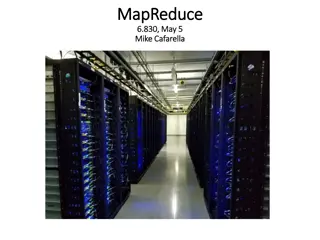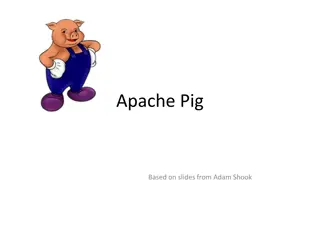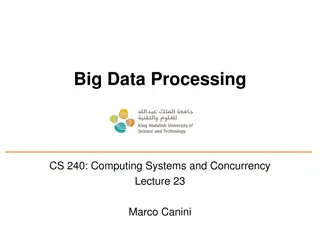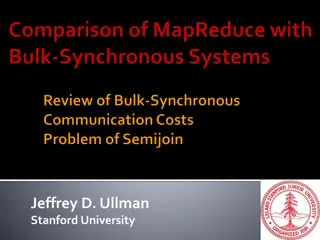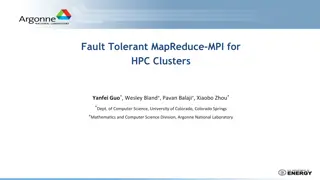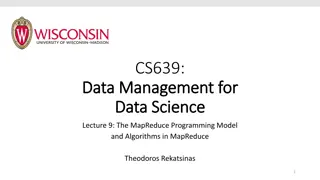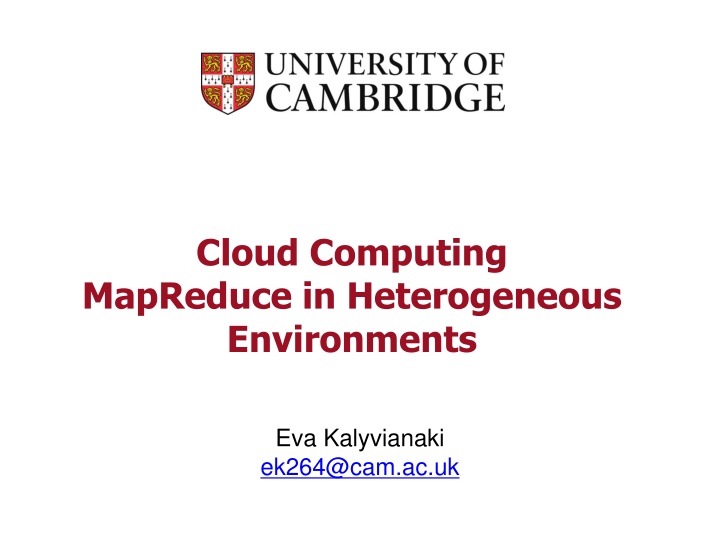
Improving MapReduce Performance in Heterogeneous Environments
Explore how MapReduce performance in heterogeneous clusters can be enhanced through techniques like speculative execution and the introduction of the LATE scheduler. Learn about challenges faced in modern clusters like those on Amazon EC2 and the impact on Hadoop's task scheduler assumptions.
Download Presentation

Please find below an Image/Link to download the presentation.
The content on the website is provided AS IS for your information and personal use only. It may not be sold, licensed, or shared on other websites without obtaining consent from the author. If you encounter any issues during the download, it is possible that the publisher has removed the file from their server.
You are allowed to download the files provided on this website for personal or commercial use, subject to the condition that they are used lawfully. All files are the property of their respective owners.
The content on the website is provided AS IS for your information and personal use only. It may not be sold, licensed, or shared on other websites without obtaining consent from the author.
E N D
Presentation Transcript
Cloud Computing MapReduce in Heterogeneous Environments Eva Kalyvianaki ek264@cam.ac.uk
Contents Looking at MapReduce performance in heterogeneous clusters Material is from the paper: Improving MapReduce Performance in Heterogeneous Environments , By Matei Zaharia, Andy Konwinski, Anthony D. Joseph, Randy Katz and Ion Stoica, published in Usenix OSDI conference, 2008 and their presentation at OSDI 2
Motivation: MapReduce is becoming popular Open-source implementation, Hadoop, used by Yahoo!, Facebook, Last.fm, Scale: 20 PB/day at Google, O(10,000) nodes at Yahoo, 3000 jobs/day at Facebook 3
Stragglers in MapReduce Straggler is a node that performs poorly or not performing at all. Original MapReduce mitigation approach was: To run a speculative copy (called a backup task) Whichever copy or original would finish first would be included Without speculative execution, a job would be slow as the slowest sub-task Google notes that speculative execution can improve job response times by 44% Is this approach good enough for modern clusters? 4
Modern Clusters: Heterogeneity is the norm Cloud computing providers like Amazon s Elastic Compute Cloud (EC2) provide cheap on-demand computing: Price: 2 cents / VM / hour Scale: thousands of VMs Caveat: less control of performance Main challenge for Hadoop on EC2 is performance heterogeneity, which breaks task scheduler assumptions This lecture/paper is on a new LATE scheduler that can cut response time in half 5
Scheduling in MapReduce When a node has an empty slot, Hadoop chooses one from the three categories in the following priority: 1. A failed task is given higher priority 2. Unscheduled tasks. For maps, tasks with local data to the node are chosen first. 3. Looks to run a speculative task. 8
Deciding on Speculative Tasks Which task to execute speculatively? Hadoop monitors tasks progress using a progress score: a number from 0, , 1 For mappers: the score is the fraction of input data read For reducers: the execution is divided into three equal phases, 1/3 of the score each: Copy phase: percent of maps that output has been copied from Sort phase: map outputs are sorted by key: percent of data merged Reduce phase: percent of data passed through the reduce function Example: a task halfway through the copy phase has progress score = 1/2*1/3 = 1/6. Example: a task halfway through the reduce phase has progress score = 1/3 + 1/3 + 1/2 * 1/3 = 5/6 9
Deciding on Speculative Tasks (cont) Hadoop looks at the average progress of each category of maps and reduces and defines a threshold: When a task s progress is less than the average for its category minus 0.2, and the task has run at least one minute, it is marked as a straggler: threshold = avgProgress 0.2 All tasks with progress score < threshold are stragglers Ties are broken by data locality This approach works reasonably well in homogeneous clusters 10
Schedulers Assumptions 1. Nodes can perform work at roughly the same rate 2. Tasks progress at constant rate all the time 3. There is no cost to starting a speculative task 4. A task s progress is roughly equal to the fraction of its total work 5. Tasks tend to finish in waves, so a task with a low progress score is likely a slow task 6. Different task of the same category (maps or reduces) take roughly the same amount of work 11
Revising Schedulers Assumptions (1) Nodes can perform work at roughly the same rate In heterogeneous clusters some nodes are slower (older) than others (2) Tasks progress at constant rate all the time Virtualized clusters suffer from co-location interference 12
Heterogeneity in Virtualized Environments VM technology isolates CPU and memory, but disk and network are shared Full bandwidth when no contention Equal shares when there is contention Timed a dd command that wrote 5000 MB of zeroes from /dev/zero to a file in parallel on 871 virtual machines in EC2 s production cluster. 2.5x performance difference 70 IO Performance per VM (MB/s) 60 50 40 30 20 10 0 1 2 3 4 5 6 7 VMs on Physical Host 13
Revising Schedulers Assumptions (3) There is no cost to starting a speculative task Too many speculative tasks can take away resources from other running tasks. (4) A task s progress is roughly equal to the fraction of its total work The copy phase of reducers is the slowest part, because it involves all-pairs communications. But this phase counts for 1/3 of the total reduce work. (5) Tasks tend to finish in waves, so a task with a low progress score is likely a slow task Tasks from different generations will be executed concurrently. So newer faster tasks are considered with older show tasks, avgProgress changes a lot. 14
Idea: Progress Rates Instead of using progress score values, compute progress rates Back up tasks with low progress rate that are far enough below the mean progress score progress rate = execution time 15
Progress Rate Example 1 min 2 min Node 1 1 task/min Node 2 3x slower 1.9x slower Node 3 Time (min) 16
Progress Rate Example What if the job had 5 tasks? 2 min Node 1 Node 2 time left: 1 min Node 3 time left: 1.8 min Time (min) Node 2 is slowest, but should back up Node 3 s task! 17
LATE Details LATE: Longest Approximate Time to End back up the task with the largest estimated finish time look forward instead of looking backward progress score progress rate = execution time 1 progress score estimated time left = progress rate Sanity thresholds: Cap number of backup tasks Launch backups on fast nodes Only back up tasks that are sufficiently slow 18
LATE Scheduler If a task slot becomes available and there are less than SpeculativeCap tasks running, then: 1. Ignore the request if the node s total progress is below SlowNodeThreshold (=25th percentile) 2. Rank currently running, non-speculatively executed tasks by estimated time left 3. Launch a copy of the highest-ranked task with progress rate below SlowTaskThreshold (=25th percentile) Threshold values: 10% cap on backups, 25th percentiles for slow node/task Validated by sensitivity analysis 19
LATE Example 2 min Estimated time left: (1-0.66) / (1/3) = 1 Node 1 Estimated time left: (1-0.05) / (1/1.9) = 1.8 Node 2 Progress = 66% Progress = 5.3% Node 3 Time (min) LATE correctly picks Node 3 20
Evaluation Environments: EC2 (3 job types, 200-250 nodes) Small local testbed Self-contention through VM placement Stragglers through background processes 21
EC2 Sort without Stragglers (Sec 5.2.1) 106 machines , 7-8 VMs per machine total of 243 VMs 128 MB data per host, 30 GB in total 486 map tasks and 437 reduce tasks average 27% speedup over native, 31% over no backups 1.4 Normalized Response Time 1.2 1 0.8 No Backups Hadoop Native LATE Scheduler 0.6 0.4 0.2 0 Worst Best Average 22
EC2 Sort with Stragglers (Sec 5.2.2) 8 VMs are manually slowed down out of 100 VMs in total running background of CPU- and disk-intensive jobs average 58% speedup over native, 220% over no backups 93% max speedup over native 2.5 Normalized Response Time 2.0 1.5 No Backups Hadoop Native LATE Scheduler 1.0 0.5 0.0 Worst Best Average 23
Conclusion Heterogeneity is a challenge for parallel apps, and is growing more important Lessons: Back up tasks which hurt response time most 2x improvement using simple algorithm 24
Summary MapReduce is a very powerful and expressive model Performance depends a lot on implementation details Material is from the paper: Improving MapReduce Performance in Heterogeneous Environments , By Matei Zaharia, Andy Konwinski, Anthony D. Joseph, Randy Katz and Ion Stoica, published in Usenix OSDI conference, 2008 and their presentation at OSDI 25



